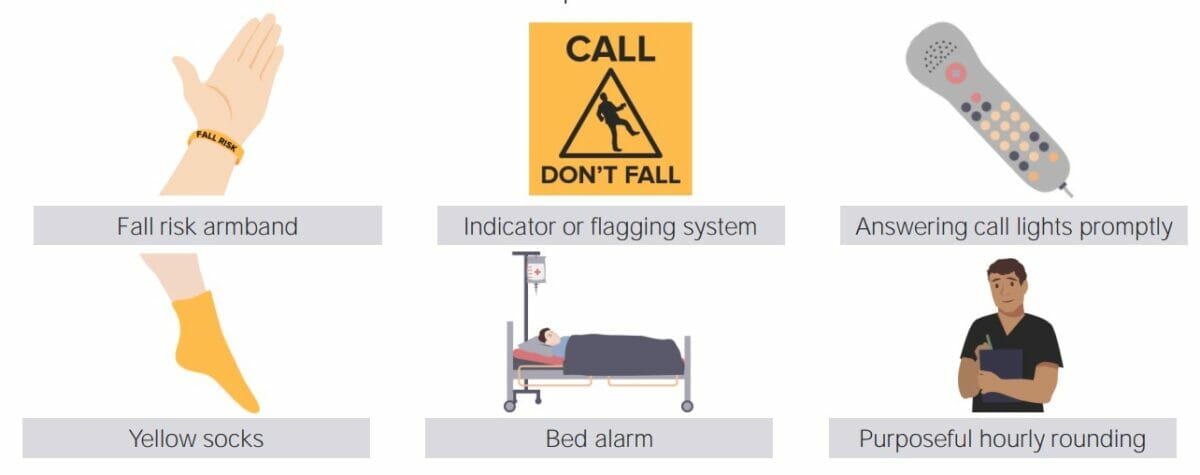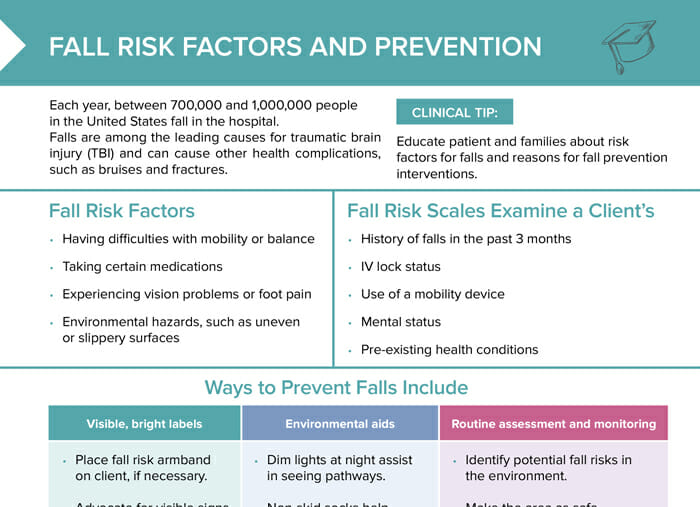What does fall risk mean?
Each year, between 700,000 and 1,000,000 people in the United States fall in the hospital. Falls are among the leading causes for traumatic brain injury (TBI) and can cause other health complications, such as bruises and fractures.
Fall risk assessment and fall risk scores
Risk factors for falls include:
- Having difficulties with mobility or balance
- Taking certain medications
- Experiencing vision problems or foot pain
- Environmental hazards, such as uneven or slippery surfaces, improper footwear
Fall risk assessment tools
Fall risk assessment tools or scales examine a client’s:
- History of falls in the past 3 months
- IV lock status
- Use of a mobility device
- Mental status
- Pre-existing health conditions
Points are assigned to these factors and evaluate the patient’s fall risk by totaling the scores.
What is the Morse fall risk scale?
The Morse fall risk scale is one of the most commonly used fall risk assessment tools. It is based on taking the client’s:
- History of falls in the past 3 months (yes: 25 points, no: 0 points)
- Does client have more than one medical diagnosis? (yes: 15 points, no: 0 points)
- Does client use ambulatory aid? (crutches/cane/walker: 15 points, furniture as support: 30 points, bedrest/wheelchair: 0 points)
- Does client have IV line? (yes: 20 points, no: 0 points)
- How stable is client’s gait? (weak: 10 points, impaired: 20 points, normal//wheelchair: 0 points)
- Mental status (forgets limitations: 15 points, oriented: 0 points)
The scores are evaluated as 0–24 points constituting a low risk of falling, 25–44 points mean medium risk, and clients reaching 45 points or more are considered at high risk of falling.
Fall prevention interventions
Ways to prevent falls include:

Visible, bright labels
- Place fall risk bracelet on client
- Advocate for visible signs about fall prevention and awareness
Environmental aids
- Dim lights at night to assist with seeing pathways
- Non-skid socks help clients move with more ease
Routine assessment and monitoring
- Identify potential fall risks in the environment
- Make the area as safe as possible to prevent falls
Fall risk nursing diagnosis
Here are some potential nursing diagnoses related to fall risk:
- Risk for falls related to:
- Altered mobility
- Medication side effects
- Cognitive impairment
- Sensory impairments
- Environmental hazards
- Impaired physical mobility related to:
- Musculoskeletal impairment
- Neurological disorders
- Risk for injury related to:
- Propensity for seizures
- Syncope or orthostatic hypotension episodes
- Confusion related to:
- Dementia or delirium
- Electrolyte imbalances or infections affecting cognitive function
Risk for fall nursing care plan
Creating a nursing care plan for a patient at risk for falls involves assessment, diagnosis, planning, interventions, and evaluation. Here’s a simplified example of a nursing care plan for “Risk for Falls”:
- Assessment:
- Patient is an 80-year-old male with a recent history of a stroke.
- Patient demonstrates unsteady gait and relies on furniture for support.
- Patient has mild cognitive impairment.
- Medications include antihypertensives.
- Nursing diagnosis:
- Risk for Falls related to unsteady gait, cognitive impairment, and side effects of medications.
- Planning:
- The patient will remain free from falls during his hospital stay.
- The patient will demonstrate the use of assistive devices for ambulation by discharge.
- The patient and family will verbalize understanding of fall prevention strategies by discharge.
- Interventions:
- Educate the patient and family on fall risks and prevention measures.
- Ensure call bell is within reach and educate the patient to call for assistance before getting up.
- Use non-skid socks or footwear.
- Ensure the patient’s environment is free of clutter.
- Install bed alarms or chair alarms to alert staff when the patient attempts to get up unassisted.
- Provide physical therapy consultation for mobility assessment and training.
- Review medications with the pharmacy or medical team to determine if any can be adjusted to reduce fall risk.
- Use appropriate signage or wristbands to identify the patient as a fall risk.
- Evaluation:
- Monitor and document any near-falls or incidents daily.
- Reassess the patient’s risk factors and adjust the care plan as needed.
- Before discharge, ensure the patient and family can demonstrate and verbalize fall prevention strategies.
What are fall risk bracelets?
Fall risk bracelets (or fall risk bands) are wristbands worn by patients in healthcare settings, such as hospitals or long-term care facilities, to visually identify the client as an increased risk for falls. The purpose of these bracelets is to alert all healthcare providers, staff, and visitors that the client requires additional precautions or assistance to prevent falls.
Fall prevention exercises
Fall prevention exercises can be encouraged to minimize clients’ risk of falls. Most effective are exercises for strengthening legs and arms (e.g., chair squats), improving balance, flexibility, and coordination, as well as practicing functional movements like getting up from a chair, and tai chi or yoga.

